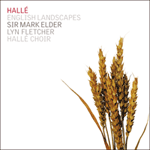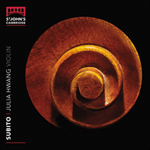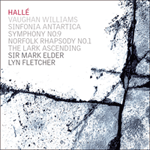
Welcome to Hyperion Records, an independent British classical label devoted to presenting high-quality recordings of music of all styles and from all periods from the twelfth century to the twenty-first.
Hyperion offers both CDs, and downloads in a number of formats. The site is also available in several languages.
Please use the dropdown buttons to set your preferred options, or use the checkbox to accept the defaults.

 PERFORMANCE
PERFORMANCE RECORDING
RECORDINGHe rises and begins to round,
He drops the silver chain of sound,
Of many links without a break,
In chirrup, whistle, slur and shake [...]
For singing till his heaven fills,
‘Tis love of earth that he instils,
And ever winging up and up,
Our valley is his golden cup,
And he the wine which overflows
To lift us with him as he goes [...]
Till lost on his aërial rings
In light, and then the fancy sings.
The lark ascending is imbued with a profound sense of communion with nature. Rather than scorning English pastoralism—as Elisabeth Lutyens and others did with observations such as 'the cowpat school'—we should value this rare quality expressed so perfectly by Vaughan Williams in particular. Like Bartók, he assimilated folk-song characteristics so thoroughly that his own melodic invention became indistinguishable—there is no actual folk-song borrowing in The lark ascending.
Following a brief introduction for woodwind and muted strings, the soloist enters with a poetic cadenza marked pianissimo and sur la touche. The solo violin part, with its gently animated flurries, impressionistically evokes the actual song of the skylark, which in nature consists of rapturous outpourings sometimes lasting unbroken for several minutes. At the re-entry of the orchestra the solo violin takes up the 6/8 melody introduced towards the end of the cadenza, but occasional arabesques continue to recall the characteristic abandon of the skylark song. Another cadenza leads to a contrasting episode (Allegretto tranquillo) with a new melody for flutes. A subsequent episode (Allegro tranquillo) begins with solo violin trills and arabesques now punctuated by off-beat triangle, before the oboe plays a further new melody marked scherzando. In each episode the solo violin part generally assumes greater melodic definition while retaining some elements of the skylark song. Both the flute melody (now on solo violin and Allegretto molto tranquillo) and the earlier 6/8 section return and the work ends with the unaccompanied violin once more in skylark mode. Vaughan Williams dedicated The lark ascending to Marie Hall, the soloist in the first performance in June 1921.
from notes by Phillip Borg-Wheeler © 2014
Elle s’élève et commence à tournoyer,
Elle dénoue de son chant la chaîne argentée
Aux maints chaînons infrangibles,
Et gazouille et sifflote son ramage intangible …
Ces vers constituent la meilleure description possible du morceau. Aujourd’hui, ces pages sont tellement aimées et connues qu’il est facile d’en oublier l’originalité et de tenir leur beauté pour acquise. Après l’entrée du violon, pendant laquelle l’alouette devient d’un coup d’aile presque aussi invisible qu’elle est difficile à entendre, l’orchestre se voit confier un bref interlude. Le thème donne l’impression—erronée—d’être une chanson populaire. Le violon ne tarde pas à rejoindre l’orchestre. Sa ligne ascendante annonce déjà, trente ans à l’avance, l’obsession de Messiaen pour les chants d’oiseaux, et sa musique présente l’atmosphère lyrico-pastorale de la poésie anglaise de l’époque géorgienne. Ce morceau fut composé en 1914 pour Marie Hall, mais Vaughan Williams le mit de côté, attendant d’avoir fini de servir pendant la Première Guerre mondiale. En 1921, Marie Hall fut la soliste lors de la création de la version orchestrale, avec Adrian Boult au pupitre. Ces pages devaient déjà faire figure d’élégie pour une certaine Angleterre en voie de disparition.
extrait des notes rédigées par Michael Kennedy © 2006
Français: David Ylla-Somers
Erhebt sich und beginnt zu kreisen,
lässt fallen silberner Töne Kette,
vielgliedrig ohne Unterbrechung,
aus Tschilpen, Pfeifen, Schleifern, Trillern …
Dieser Vers eignet sich wohl so gut wie nur denkbar als Beschreibung der Musik. Das Werk ist heute so beliebt und weithin bekannt, dass seine Originalität leicht übersehen und seine Schönheit als selbstverständlich hingenommen wird. Nach dem Einsatz der Violine, in dessen Verlauf die Lerche bis fast außerhalb unserer Sichtund Hörweite aufsteigt, hat das Orchester ein kurzes Zwischenspiel. Das Thema klingt wie eine Volksweise, ist jedoch keine. Die Violine gesellt sich bald wieder zum Orchester. Ihre hoch aufsteigende Melodielinie nimmt Messiaens Faszination mit Vogelgesang um dreißig Jahre vorweg und fängt die lyrisch-pastorale Atmosphäre englischer georgianischer Dichtung in Musik ein. Das Werk entstand 1914 für Marie Hall, doch Vaughan Williams legte es beiseite, bis er vom Militärdienst im Ersten Weltkrieg zurückkehrte. Sie war dann die Solistin bei der Uraufführung der Orchesterfassung im Jahre 1921 unter der Leitung von Adrian Boult. Das Werk muss seinerzeit bereits wie eine Elegie auf ein im Verschwinden begriffenes England geklungen haben.
aus dem Begleittext von Michael Kennedy © 2006
Deutsch: Bernd Müller
Warwick Thompson © 2003
 English landscapes English landscapes‘The lark ascending is … ravishingly beautiful and with such fine sound, Lyn Fletcher's playing is truly a soul warming experience’ (Classical.net)» More |
 Janine Jansen Janine Jansen‘Here is an artist of real magnetism … the recorded balance is close, with the orchestra, like the soloist, larger than life. This especially sui ...» More |
 Subito SubitoA stunning debut album from violinist Julia Hwang embraces works by Grieg, Lutosławski, Vaughan Williams and Wieniawski.» More |
 Vaughan Williams: Sinfonia antartica & Symphony No 9 Vaughan Williams: Sinfonia antartica & Symphony No 9Evolving from Vaughan Williams's score for the 1948 film 'Scott of the Antarctic', the 'Sinfonia antartica' is one of the composer's most unusual works, its scoring including wordless solo soprano and women’s chorus, organ, piano and extensive tun ...» More |

